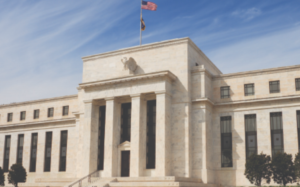While important, it should not be the sole driver of your investment decisions The Federal Reserve p...
Oct 03, 2023
U.S. Economy: Soft Landing or Delayed Recession?
Economists have been predicting a recession for the U.S. economy ever since the Federal Reserve began
aggressively raising interest rates in 2022. This is Econ 101. High interest rates, which make it more
expensive to borrow, are intended to tame inflation by slowing business and consumer spending. A rapid
and extreme increase in rates, as the Fed has carried out over the last year and a half, can be expected to
slam the economy into reverse. The classic example is the early 1980s, when the Fed pushed the economy
into a deep recession in order to stop runaway double-digit inflation.1
So far, the economy is proving resilient in the face of interest-rate pressure. Inflation, as measured by the
12-month change in the consumer price index (CPI), dropped from a high of 9.1% in June 2022 to 3.2% in
July 2023. Growth in real gross domestic product (GDP) was a solid 2.1% in Q2 2023, and the August
unemployment rate was 3.8%, up from 3.5% in July but still near a 50-year low.2–3 These "headline"
numbers suggest an economy coming in for a "soft landing" — a term for controlling inflation without serious economic damage. As with most headlines, however, the full story is more complex.
Long-term inflation prospects
Although consumers may notice the ups and downs of prices, the Fed is primarily concerned with
controlling the longer-term inflationary trend. Its preferred measure is the price index for personal
consumption expenditures (PCE), which captures a wider range of spending than the CPI, and the target
for a healthy economy is PCE inflation of 2.0%. The 12-month change in the PCE price index was 3.3% in
July 2023, down from a high of 7.0% in June 2022. The Fed also looks closely at "core" PCE, which
excludes volatile food and energy prices and ran at a 4.2% 12-month rate in July. These numbers have
trended downward over the last year, but they ticked upward in July and are still above the Fed's target. It
remains to be seen whether further increases in interest rates will be necessary.4
A slower but sound labor market
Despite rising rates and predictions of a recession, businesses have continued to hire workers at a solid
pace. The 187,000 jobs added in August was slower than post-pandemic job growth (over 200,000 jobs for
29 months) but a solid bounceback from lows of 105,000 in June and 157,000 in July.5 Unlike typical
recessions, when lower-paid workers are often the first to go, recent layoffs have tended to be in industries
like finance and tech, where higher-paid workers typically have other job prospects and savings to maintain financial stability. Some analysts have called this a "richcession" (though the workers are hardly rich), and it may be dampening the effects of a jobs slowdown on the broader economy.6
Strong spending by businesses and consumers
Steady hiring is one indication that businesses are continuing to spend and expand. The Q2 GDP report
also showed increased investments in equipment, nonresidential structures, and intellectual property.7 All
of these point to expectations of business growth. Many companies restructured their debt when interest
rates were low, which has delayed the impact of higher borrowing costs, and may put off widespread
effects for some time.8
Consumer spending accounts for two-thirds of GDP, and increased spending was a key contributor to Q2
GDP growth. Spending accelerated even further in July, increasing 0.8% over June — the largest
month-over-month increase since January.9 Like businesses, many consumers still carry debt with low
interest rates, providing more discretionary income.10 Spending may slow as pandemic-era savings dwindle and student loan payments resume, but a strong job market could help maintain consumer
momentum.11
Expectations and the wage-price spiral
Two factors that can drive inflation are consumer expectations and the so-called wage-price spiral — when
rapidly rising wages push demand and a willingness to pay higher prices, which leads to higher wages and
more demand. Both of these seem to be settling. In a July 2023 survey, consumer expectations for inflation
in one year dropped to 3.5% — the lowest since April 2021 — while expectations for three and five years
dropped to 2.9%.12 Average hourly earnings increased 4.3% for the 12-month period ending August 2023,
higher than the rate of inflation but down from 5.4% a year earlier.13
Signs of trouble remain
Although most current data indicates that inflation is cooling with a modest economic slowdown, it takes
time for interest rate changes to work their way through the economy. Pessimists point to measures that
suggest a recession may still be on the way. The Conference Board Leading Economic Index, a suite of 10
statistics that tend to rise and fall ahead of the broader economy, fell for the 16th straight month in July
2023.14 The yield curve (yields of U.S. Treasury securities by maturity date) has been inverted since
mid-2022, and the disparity between the 2-year and 10-year Treasuries, traditionally a sign of a coming
recession, reached its most extreme inversion since 1981 in early July.15
More optimistic analysts suggest that these indicators may not apply to the current situation: a strong
economy briefly derailed by the pandemic, with a big, fast bounceback and inflation due to supply-chain
disruptions and pent-up demand. In this view, the economy is finding its footing after these extremes and
may be poised for extended growth. Time will tell, but for now the predicted recession seems hard to find.
U.S. Treasury securities are guaranteed by the federal government as to the timely payment of principal
and interest, but their principal value fluctuates with market conditions. If not held to maturity, they could be worth more or less than the original amount paid. Forecasts are based on current conditions, are subject to change, and may not come to pass.
Sources/Notes
1, 10) The Wall Street Journal, July 27, 2023
2, 5, 13) U.S. Bureau of Labor Statistics, 2023
3–4, 7, 9) U.S. Bureau of Economic Analysis, 2023
6) Associated Press, July 29, 2023
8) Insider, July 21, 2023
11) Reuters, August 15, 2023
12) Federal Reserve Bank of New York, August 14, 2023
14) The Conference Board, August 17, 2023
15) CNBC, July 7, 2023
Broadridge Investor Communication Solutions, Inc. does not provide investment, tax, or legal advice. The
information presented here is not specific to any individual's personal circumstances.
To the extent that this material concerns tax matters, it is not intended or written to be used, and cannot be used, by a taxpayer for the purpose of avoiding penalties that may be imposed by law. Each taxpayer
should seek independent advice from a tax professional based on his or her individual circumstances.
These materials are provided for general information and educational purposes based upon publicly
available information from sources believed to be reliable—we cannot assure the accuracy or completeness of these materials. The information in these materials may change at any time and without notice.
You may also like
Aug 2, 2019
On Wednesday, July 31st, 2019 the Federal Reserve decided to cut interest rates for the first time s...
Oct 30, 2017
Do investors rely on emotion when investing? Many behavioral economists and psychologists believe th...









